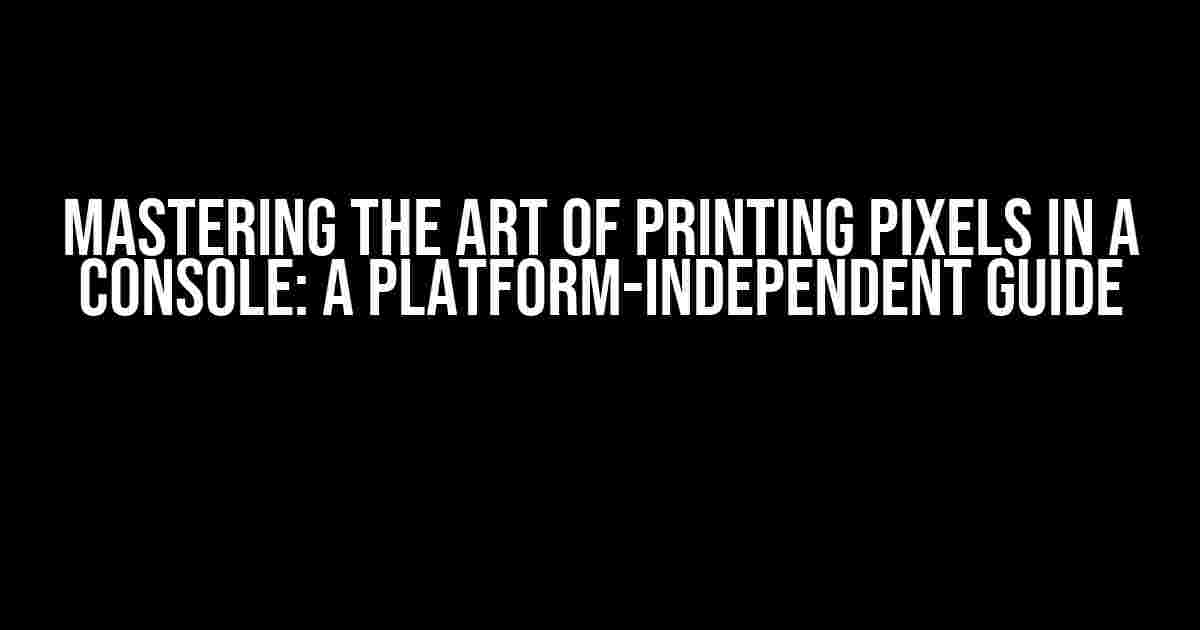Are you tired of being limited by platform-specific constraints when trying to print pixels in a console? Look no further! In this comprehensive guide, we’ll take you on a journey to explore the world of console-based pixel printing, independently of the platform. Buckle up, and let’s dive into the exciting realm of pixel art!
What is Pixel Art?
Pixel art is a graphic design technique that uses small, square pixels to create images. It’s a nostalgic reminder of the early days of video games and computer graphics. In the context of console-based programming, printing pixels involves manipulating the console’s output to create graphical representations using characters and colors.
Why Print Pixels in a Console?
There are several reasons why printing pixels in a console is an attractive concept:
-
Platform independence: By using console-based programming, you can create pixel art that’s not limited to a specific platform, making it accessible to a wider audience.
-
Low-level control: Console-based programming provides direct access to the console’s output, giving you fine-grained control over the pixels.
-
Creative freedom: Printing pixels in a console allows you to push the boundaries of traditional graphics programming, exploring new ways to create interactive and immersive experiences.
Choosing the Right Platform
Before we dive into the nitty-gritty of printing pixels, it’s essential to choose a platform that supports console-based programming. Here are some popular options:
| Platform | Description |
|---|---|
| Python | A high-level, interpreted language with extensive libraries and a large community. |
| C++ | A low-level, compiled language with direct access to system resources. |
| Rust | A systems programming language with a focus on safety and performance. |
| JavaScript (Node.js) | A high-level, interpreted language with a vast ecosystem and extensive libraries. |
Printing Pixels in a Console: The Basics
Now that we’ve chosen our platform, let’s explore the fundamental concepts of printing pixels in a console:
### Coordinates and Pixels
In a console, pixels are represented by characters and colors. We’ll use a 2D coordinate system to position pixels on the console:
(x, y) | +-------> x-axis | | v y-axis
In this system, the origin (0, 0) is at the top-left corner of the console. We’ll use (x, y) coordinates to specify the position of each pixel.
### Colors and Characters
To print pixels, we’ll use a combination of characters and colors. Here’s a breakdown of the available characters and colors:
| Character | Description |
|---|---|
| ‘ ‘ | Space character ( transparent pixel) |
| ‘▀’ | Solid block character (filled pixel) |
| ‘▄’ | Lower half block character (half-filled pixel) |
| ‘▅’ | Upper half block character (half-filled pixel) |
We’ll use these characters to create pixels with different colors and shades.
### Printing Pixels
Now that we have our coordinates, characters, and colors, let’s print some pixels! Here’s an example in Python:
import os
# Clear the console
os.system('cls' if os.name == 'nt' else 'clear')
# Set the console dimensions
width, height = 80, 24
# Create a 2D array to store pixel data
pixels = [[(0, 0, 0) for _ in range(width)] for _ in range(height)]
# Draw a red pixel at (10, 10)
pixels[10][10] = (255, 0, 0)
# Print the pixel data
for y in range(height):
for x in range(width):
r, g, b = pixels[y][x]
print(f"\x1b[48;2;{r};{g};{b}m▀\x1b[0m", end='')
print()
This code creates a 2D array to store pixel data, sets the console dimensions, and draws a red pixel at (10, 10). The pixel is printed using ANSI escape sequences to set the background color.
Advanced Techniques
Now that we’ve covered the basics, let’s explore some advanced techniques to take your pixel art to the next level:
### Dithering
Dithering is a technique used to create the illusion of more colors by scattering pixels of different colors.
import random
# Create a 2D array to store pixel data
pixels = [[(0, 0, 0) for _ in range(80)] for _ in range(24)]
# Dithering function
def dither(x, y, r, g, b):
chance = 0.5
if random.random() < chance:
pixels[y][x] = (r, g, b)
# Dither a 5x5 red square
for y in range(10, 15):
for x in range(30, 35):
dither(x, y, 255, 0, 0)
# Print the pixel data
for y in range(24):
for x in range(80):
r, g, b = pixels[y][x]
print(f"\x1b[48;2;{r};{g};{b}m▀\x1b[0m", end='')
print()
This code uses a dithering function to scatter red pixels within a 5×5 area, creating a subtle gradient effect.
### Animation
Let’s bring our pixel art to life by adding animation! We’ll use a simple animation loop to update the pixel data:
import time
# Create a 2D array to store pixel data
pixels = [[(0, 0, 0) for _ in range(80)] for _ in range(24)]
# Animation function
def animate(x, y, r, g, b):
for frame in range(10):
# Update pixel data
pixels[y][x] = (r, g, b)
# Print the pixel data
for y in range(24):
for x in range(80):
r, g, b = pixels[y][x]
print(f"\x1b[48;2;{r};{g};{b}m▀\x1b[0m", end='')
print()
# Wait for 0.1 seconds
time.sleep(0.1)
# Clear the console
os.system('cls' if os.name == 'nt' else 'clear')
# Animate a 5x5 red square
for y in range(10, 15):
for x in range(30, 35):
animate(x, y, 255, 0, 0)
This code uses an animation function to update the pixel data and print it to the console, creating a simple animation effect.
Conclusion
And that’s it! You’ve now mastered the art of printing pixels in a console, independently of the platform. With these techniques, you can create stunning pixel art, animations, and interactive experiences. Remember to experiment, push boundaries, and have fun!
As you continue to explore the world of pixel art, keep in mind that the possibilities are endless. You can create games, simulations, and even interactive stories using these techniques. The console is your canvas, and the pixels are your paint!
Happy coding, and see you in the pixelated world!
Frequently Asked Questions
Here are some common questions and answers to help you get started:
-
What is the best platform for printing pixels in a console?
The best platform depends on your personal preferences and the type of project you’re working on. Python is a popular choice for beginners, while C++ and Rust offer more low-level control.
-
How do I clear the console in different platforms?
Use
os.system('cls' if os.name == 'nt' else 'clear')in Python,std::system("clear")in C++, or <Frequently Asked Question
Got questions about print pixel in a console platform-independent way? We’ve got answers!
What is a pixel in the context of console printing?
A pixel, short for picture element, is the smallest unit of a graphical element that can be displayed on a screen. In the context of console printing, a pixel refers to a single character on the screen that can be manipulated to create simple graphics or text-based interfaces.
Why is it important to print pixels in a console platform-independent way?
Printing pixels in a console platform-independent way ensures that your application can run seamlessly across different operating systems and terminals, without worrying about compatibility issues or distorted output. This approach allows for a consistent and predictable user experience, regardless of the platform.
What are some common challenges when trying to print pixels in a console platform-independent way?
Some common challenges include dealing with varying character sets, font sizes, and encoding schemes across different platforms. Additionally, handling console resizing, scrolling, and cursor movement can also be tricky. These challenges can be overcome by using platform-agnostic libraries and clever coding techniques.
How do I print a pixel at a specific location on the console?
To print a pixel at a specific location, you’ll need to use a combination of escape sequences, such as ANSI escape codes or VT100 codes, to move the cursor to the desired position and then print the desired character. For example, in C, you can use the `printf` function with escape sequences to achieve this.
What are some popular libraries for printing pixels in a console platform-independent way?
Some popular libraries for printing pixels in a console platform-independent way include ncurses, conio, and terminfo. These libraries provide a set of functions and utilities that allow you to manipulate the console output, making it easier to print pixels and create graphical interfaces.



